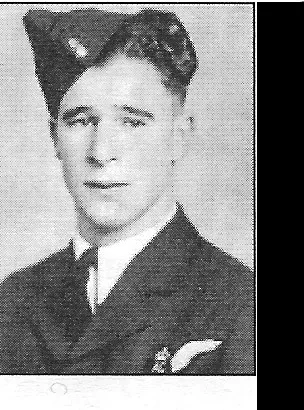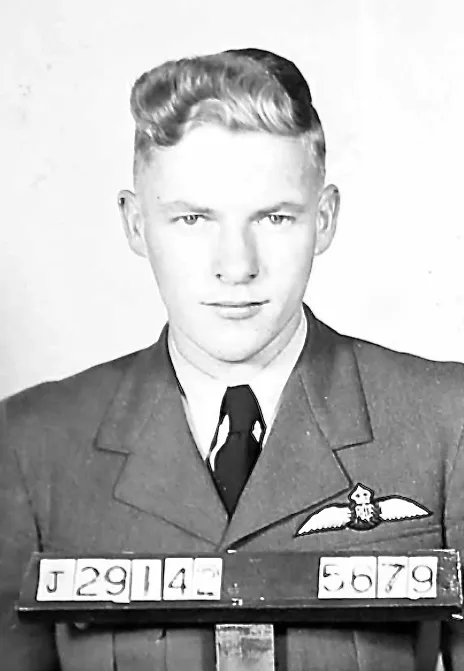Rielly, Charles Thomas
Killed in Action 1945-01-12


Birth Date: 1922-June-11
Born: Winnipeg, Greater Winnipeg, Manitoba, Canada
Son of Charles T and Mary E Reilly, of Montreal, Quebec
Home: Montreal, Quebec
Enlistment: Montreal, Quebec
Enlistment Date: 1942-04-28
Service
RCAF
Unit
424 (B) Sqn- Squadron
Castigandos Castigamus Chastise those deserving
Base
RAF Skipton-on-Swale
Rank
Pilot Officer
Position
Flight Sergeant
Service Numbers
J/94243
Prev: R/189556
Home
 Montreal, Quebec
Montreal, Quebec
Target
 Flensburg Germany
Flensburg Germany
First Burial
 Aabenraa Cemetery, Jutland, Denmark
Aabenraa Cemetery, Jutland, Denmark
Wireless Operator/Air-Gunner Flight Sergeant CT Reilly (RCAF) baled but hit a tree in the Holbol Marsh and was knocked unconscious. Sadly, he froze to death before he was found by local civilians 1945-01-18 who brought his body to the church in Hobol. German Wehrmacht soldiers from Sogarrd brought Pilot Officer Rielly's to Aabenraa Cemetery where he was laid to rest 1945-01-25
Halifax B.Mk.III NP947
Minelaying Flensburg Germany 1945-January-12 to 1945-January-12
424 (B) Sqn (RCAF) RAF Skipton-on-Swale
<424 Tiger Squadron (Castigandos Castigamus) RAF Skipton on Swale. Halifax BIII aircraft NP 947 QB-Y was attacked by night fighter pilot Hauptman Eduard Schroder of 3/NJG 3 after dropping their payload during GARDENING (mining) operation to Flensburg Fjord between Germany and Denmark. The order to bale was given before the bomber crashed into the fjord near Schausende, Germany with the loss of all but one crew memberFlying Officer MC Grant (RCAF), Pilot Officer WE Archer (RCAF), Pilot Officer RC Carnegie (RCAF), Flying Officer MG Fife (RCAF), Pilot Officer CT Rielly (RCAF) and Pilot Officer J Pollard (RAFVR) were all killed in action
Navigator Flying Officer JG Agnew (RCAF) was the sole survivor from his crew and was taken as a Prisoner of War
On 1945-01-15, Squadron Leader A. Ross Dawson, the Chief Technical Officer with 424/433 Sqns at Skipton on Swale, after returning from leave, wrote in his diary:
"Jan 12 . . . 5 from each sqdn were put up on bombing & 3 from each on mining. The bombing was finally scrubbed but the gardening effort got off ok with no non-starters or early returns. However 424 had some bad luck & 2 of their 3 kites didn't come aback including F/Lt Mackie one of my good friends here " and he only had two more trips to do here unfortunately"
There is some confusion regarding the 424 Squadron serial of this aircraft, stated on the HH card and some other sources as LV 998 but with the Squadron ORB stating serial NP 947. CASPIR has accepted the ORB information as correct
There were two 424 Squadron Halifax III aircraft lost on this operation. Please see aircraft serial Halifax MZ 805 QB-X [Royal Air Force Serial and Image Database]...
[Royal Air Force Serial and Image Database]... [Royal Air Force Serial and Image Database]...
[Royal Air Force Serial and Image Database]... Halifax III NP 947 crashed in Flensburg Fjord 12/1-1945
Halifax III NP 947 crashed in Flensburg Fjord 12/1-1945
Halifax NP947
Handley Page Halifax

The Handley Page Halifax is a British Royal Air Force (RAF) four-engined heavy bomber of the Second World War. It was developed by Handley Page to the same specification as the contemporary twin-engine Avro Manchester.
The Halifax has its origins in the twin-engine HP56 proposal of the late 1930s, produced in response to the British Air Ministry's Specification P.13/36 for a capable medium bomber for "world-wide use." The HP56 was ordered as a backup to the Avro 679, both aircraft being designed to use the underperforming Rolls-Royce Vulture engine. The Handley Page design was altered at the Ministry to a four-engine arrangement powered by the Rolls-Royce Merlin engine; the rival Avro 679 was produced as the twin-engine Avro Manchester which, while regarded as unsuccessful mainly due to the Vulture engine, was a direct predecessor of the famed Avro Lancaster. Both the Lancaster and the Halifax would emerge as capable four-engined strategic bombers, thousands of which would be built and operated by the RAF and several other services during the War.
On 25 October 1939, the Halifax performed its maiden flight, and it entered service with the RAF on 13 November 1940. It quickly became a major component of Bomber Command, performing routine strategic bombing missions against the Axis Powers, many of them at night. Arthur Harris, the Air Officer Commanding-in-Chief of Bomber Command, described the Halifax as inferior to the rival Lancaster (in part due to its smaller payload) though this opinion was not shared by many of the crews that flew it, particularly for the MkIII variant. Nevertheless, production of the Halifax continued until April 1945. During their service with Bomber Command, Halifaxes flew a total of 82,773 operations and dropped 224,207 tons of bombs, while 1,833 aircraft were lost. The Halifax was also flown in large numbers by other Allied and Commonwealth nations, such as the Royal Canadian Air Force (RCAF), Royal Australian Air Force (RAAF), Free French Air Force and Polish forces.Wikipedia
 National Air Force Museum of Canada
National Air Force Museum of Canada
424 (B) Sqn Castigandos Castigamus ("Tiger")
History of the Squadron during World War II (Aircraft: Wellington III, X, Halifax III, Lancaster I, III)

424 Squadron was the sixth RCAF bomber squadron to be formed overseas in WWII, at Topcliffe, Yorkshire, UK on October 15, 1942, originally as part of No 4 Group of RAF Bomber Command. It remained at Topcliffe when it was transferred to the newly-formed 6 (RCAF) Group on January 1, 1943. It moved to Leeming, Yorkshire , and then Dalton, Yorkshire , flying Vickers Wellington Mk III and X aircraft before being dispatched on June 22, 1943 to No 331 (RCAF) Wing of No 205 Group in Tunisia (Kairouan/Zina and Hani East airfields), from where it flew in support of the invasions of Sicily and Italy. It returned by sea to Skipton-on-Swale, Yorkshire in October/November 1943. It re-equipped with Handley Page Halifax Mk III aircraft, which it flew until January 1945, when it re-equipped with Avro Lancaster I and III aircraft. After the termination of hostilities in Europe, the squadron was transferred to No 1 Group, and was employed in operation DODGE, the repatriation of British and Canadian troops from Italy. It was disbanded at Skipton on October 15, 1945, 3 years to the day since its formation.
In the course of hostilities, the squadron flew 3257 sorties for the loss of 52 aircraft. 8776 tons of bombs were dropped. Crew members were awarded 1 DSO, 49 DFC's and 1 Bar to DFC, 1 CGM, 11 DFM's and 1 MiD. Battle Honours were: English Channel and North Sea 1943-45, Baltic 1944-45, Fortress Europe 1943-44, France and Germany 1944-45, Biscay Ports 1943-44, Ruhr 1943-45, Berlin 1944, German Ports 1943-45, Nornamdy 1944, Rhine, Bisacy 1943-44, Sicily 1943, Italy 1943, Salerno.Wikipedia, Kostenuk and Griffin
Squadron History (Bomber Command Museum PDF)
Maps for Movements of 424 Squadron 1942-45
 MAP 1: 424 Squadron Movements 1942-45 (right-click on image to display enlarged in new tab) |  MAP 2: 424 Squadron Movements 1942-45 (detail of Map 1) |  MAP 3: 424 Squadron Movements in North Africa 1943 |

424 Squadron History Summary 1942-45

424 Squadron History Summary 1942-45 Page 2

History of the Squadron Post-WWII (Aircraft: Harvard II, Mustang IV, Silver Star 3, Expeditor, Otter, Griffon, Hercules)
The squadron was re-formed at Mount Hope, Hamilton, Ontario on 15 April 1946, as a light bomber unit. It was redesignated as an auxiliary fighter unit on 1 April 1947. It flew North American Harvard II and Mustang IV aircraft in a fighter role, as well as Canadair Silver Star aircraft until 1 September 1957 when it was then reassigned as a light transport and emergency rescue role and re-equipped with Beechcraft Expeditor and de Havilland Otter aircraft. On 21 October 1961 the unit received its Squadron Standard for 25 years’ service as No. 119 and 424 Squadron. A reduction of the Auxiliary Force resulted in the squadron being disbanded on 1 April 1964. On 8 July 1968, with unification of the Canadian Forces, the squadron was reactivated as 424 Communications and Transport Squadron, operating from CFB Trenton, Ontario . The squadron has flown more than 14 different types of aircraft during its history.
424 (Tiger) Squadron is now a Transport and Rescue Squadron based at 8 Wing Trenton. To fulfil its roles, 424 Squadron operates the CH-146 Griffon helicopter and the CC-130H Hercules. 424 Squadron and 435 Transport and Rescue Squadron provide primary search and rescue response for the Trenton Search and Rescue Region (SRR), the largest in Canada. The Trenton SRR extends from Quebec to the British Columbia/Alberta border, and from the Canada/United States border to the North Pole. The Squadron crews one aircraft of each type on standby response posture in order to respond to distress cases as tasked by Joint Rescue Coordination Centre Trenton.
In addition to providing SAR response through a para-rescue capability, the CC-130H Hercules allows the squadron to conduct its transport role in Canada and around the world. The CH-146 Griffon enables rescues and medical evacuations from locations on land and over water. Both aircraft carry Search and Rescue Technicians onboard in order to provide urgent care to those in need. The members of 424 Squadron provide SAR response to incidents under the federal SAR mandate; all aircraft incidents and all marine incidents in waters under federal jurisdiction. They also support humanitarian missions and other SAR organizations when able. Wikipedia and www.canada.ca/en/air-force/corporate/squadrons/424-squadron.html
 Canadian Virtual War Memorial
Canadian Virtual War Memorial Commonwealth War Graves Commission
Commonwealth War Graves Commission www.findagrave.com
www.findagrave.com






 Halifax Heavy Bomber WWII
Halifax Heavy Bomber WWII Wikipedia Halifax Bomber
Wikipedia Halifax Bomber